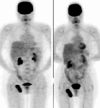Use of S-100B to evaluate therapy effects during bevacizumab induction treatment in AJCC stage III melanoma
- PMID: 21861214
- PMCID: PMC3264856
- DOI: 10.1245/s10434-011-2027-2
Use of S-100B to evaluate therapy effects during bevacizumab induction treatment in AJCC stage III melanoma
Abstract
Aim: To investigate the feasibility of using bevacizumab to improve the survival of American Joint Committee on Cancer (AJCC) stage III melanoma patients, we investigated how a single bevacizumab treatment affected nodal disease and a panel of biomarkers in clinically fluorodeoxyglucose positron emission tomography (FDG-PET)/computed tomography (CT)-staged, stage III melanoma patients, prior to therapeutic lymph node dissection (TLND).
Methods: Four weeks before TLND, nine patients (median age 50, range 28.8-62.1 years; two male, seven female) with palpable lymph node metastases received 7.5 mg/kg bevacizumab. Before and after this treatment, all patients were assessed by measurements of the maximum standardized uptake value (SUVmax) by FDG-PET scan, and serum S-100B and lactate dehydrogenase (LDH). After TLND, the dissection specimen was analyzed for number of removed lymph nodes, number of metastatic lymph nodes, and tumor necrosis.
Results: Median follow-up was 15.5 (2.2-32.9) months. Histopathological analysis revealed tumor necrosis in six patients, of whom five had an S-100B decline and one had an unchanged S-100B level after bevacizumab. The other three patients showed an S-100B increase and no necrosis. Tumor necrosis was correlated with S-100B decrease (P = 0.048). No association was found between necrosis and the markers SUVmax and LDH. No wound healing disturbances were encountered.
Conclusion: Tumor necrosis in dissection specimens was associated with declining S-100B levels, while elevated S-100B was only found in cases with no necrosis. Bevacizumab might be useful in treating AJCC stage III melanoma patients prior to TLND, and S100-B appears to be a useful marker for assessment of treatment effects.
Figures
References
-
- Speijers MJ, Francken AB, Hoekstra-Weebers JEHM, et al. Optimal follow-up for melanoma. Expert Rev Dermatol. 2010;5:461–478. doi: 10.1586/edm.10.38. - DOI
MeSH terms
Substances
LinkOut - more resources
Full Text Sources
Medical
Miscellaneous



